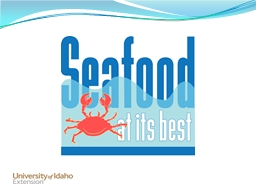

S eafood at I ts B est Lesson 1 Goals Provide a brief introduction to the US seafood industry Participants will gain a better understanding of the large variety of seafood products available ID: 1021998
Download Presentation The PPT/PDF document "Lesson 1 What Is Seafood?" is the property of its rightful owner. Permission is granted to download and print the materials on this web site for personal, non-commercial use only, and to display it on your personal computer provided you do not modify the materials and that you retain all copyright notices contained in the materials. By downloading content from our website, you accept the terms of this agreement.
1.
2. Lesson 1What Is Seafood?Seafood at Its Best
3. Lesson 1 GoalsProvide a brief introduction to the U.S. seafood industryParticipants will gain a better understanding of the large variety of seafood products available.3
4. Increase knowledge of the following:What is seafood?Where does our seafood come from?Consumer preferencesFuture seafood supply and demand4Lesson 1 Objectives
5. Definition of Seafood Seafood includes freshwater and saltwater:FishMolluscan shellfishCrustaceansCommercially caught or farm raised5
6. FishAquatic vertebrates that have gills, fins, and usually an elongated body covered with scalesRainbow trout, catfish, tilapia, flatfish, pollock, salmon, tuna6
7. Molluscan ShellfishAquatic invertebrates characterized by a shell (sometimes lacking) of one or more pieces that wholly or partly enclose the soft, unsegmented bodyOysters, clams, mussels, scallops7
8. CrustaceansArthropod animals characterized by a hard, close-fitting shell that is shed periodicallyCrabs, lobsters, shrimp, crayfish8
9. Imported SeafoodAbout 5.3 billion pounds of edible seafood is imported annually, which results in a $10.4 billion trade deficitAbout 90% of seafood is importedImports are mostly from China, Thailand, Canada, Indonesia, and Vietnam Leading seafood imports by value: shrimp, lobster, salmon, canned tuna9
10. Aquaculture Aquaculture (fish farming) – production of aquatic animals and plants under controlled conditions for all or part of the life cycle Approximately 48% of world seafood supply comes from aquacultureCommon aquaculture species include:rainbow trout, catfish, salmon, shrimp, clams and oysters10
11. 11
12. Advantages of AquacultureSteady supplyConsistent qualityModerating pricesUniform product size12
13. U.S. Aquaculture High-quality, safe, wholesome, and affordable seafoodFarm-gate value of over $1 billionProvides employment in rural areas13
14. U.S. Aquaculture CatfishCatfish represents the largest domestic aquaculture industry in the U.S.Approximately 300 million pounds produced in 2012Leading catfish-producing states include Mississippi, Alabama, Arkansas, and LouisianaCatfish are grown in earthen ponds and fed grain-based feeds14
15. Rainbow trout are grown both for the table and for stocking pondsProduced in flow-through racewaysRainbow trout are grown in numerous statesIn 2012, 47.7 million ponds of market-size trout produced15U.S. Aquaculture rainbow trout
16. U.S. Aquaculture Other SpeciesOther species grown for food include salmon, hybrid striped bass, tilapia, sturgeon, crayfish, shrimp, oysters, clams and mussels16
17. 17
18. Top 10 Species Consumed U.S. Per Capita (lbs.)20012011SpeciesPoundsSpeciesPoundsShrimp3.40Shrimp 4.20Canned Tuna2.90Canned Tuna2.60Salmon2.02Salmon1.95Alaska Pollock1.21Alaska Pollock1.31Catfish1.15Tilapia1.29Cod0.56Pangasius0.63Clams0.47Catfish0.56Crab0.44Crab0.52Flatfish0.39Cod0.50Scallops0.35Clams0.3318
19. 19Preferred Product Type 2011
20. Where Do We Eat Seafood?Americans eat most seafood away from home at food service establishments such as restaurantsSignificant amounts of low-cost, familiar, or easily prepared items such as canned tuna, salmon, tilapia, and shrimp are consumed at home 20“Fisherman’s Wharf” by Katharine Shilcutt”Smoked Wild Canned Fish (The Fishery) by Renee S. Suen
21. How Much Money Do We Spend on Seafood?In 2011 – $57.7 billion at food service establishments (restaurants, carry-outs, caterers, etc.)In 2011 – $27.6 billion in retail sales for home consumptionAverage household spending for in-home seafood purchases in 2011 was $117Asian, African & Hispanic Americans; higher income; and older households spend more on seafood21
22. Future U.S. Seafood DemandUSDA predicted per capita consumption would be 16 pounds by 2020There is a potential need by 2020 of an additional 4 to 5 billion pounds (round weight) to satisfy demand22
23. Population Demographics Will Influence Seafood DemandBy 2020, 84 million Americans will be over the age of 60They will eat more seafood, dine out more often, and prefer prepared meals for in-home consumptionContinued growth of minority populationMinorities eat more seafood than the national average23
24. Future Seafood Markets Organic seafood: small volume, high value“Functional” seafood with FDA-approved health claims and/or added nutrientsGreater convenience: heat-and-eat entrees, “ready to cook” meals24
25. ?Where Will OurSeafood Come From?25
26. Future Seafood SupplyProduction from capture fisheries has leveled off, and most fishing areas have reached maximum potentialEstimate: at current consumption levels, global seafood supplies will need to increase by ~ 30 million tons by 2030Aquaculture will continue to be an important source of seafood26
27. SummarySeafood includes freshwater & saltwater fish, molluscan shellfish, and crustaceansAlmost all of our seafood is importedAquaculture supplies about 48% of all seafood worldwideAmericans consume around 15 1/2 pounds of seafood each per year27
28. SummaryThe three most popular sea foods are:Shrimp, canned tuna, and salmonThey comprised 58% by weight of the seafood we consumed in 2011Aquaculture supplies a significant amount of shrimp and salmonMajority of seafood products (72%) are fresh and frozen and the balance canned or cured28
29. SummaryMost seafood is consumed away from home, where two-thirds of our seafood dollars are spentPopulation demographics will impact seafood demandAquaculture will be a major supplier of seafood in the future 29
30. Photo credits | licensed under Creative Commons “Fisherman’s Wharf” - CC BY-NC 2.0“Smoked Wild Canned Fish (The Fishery)” - CC BY-NC-ND 2.0